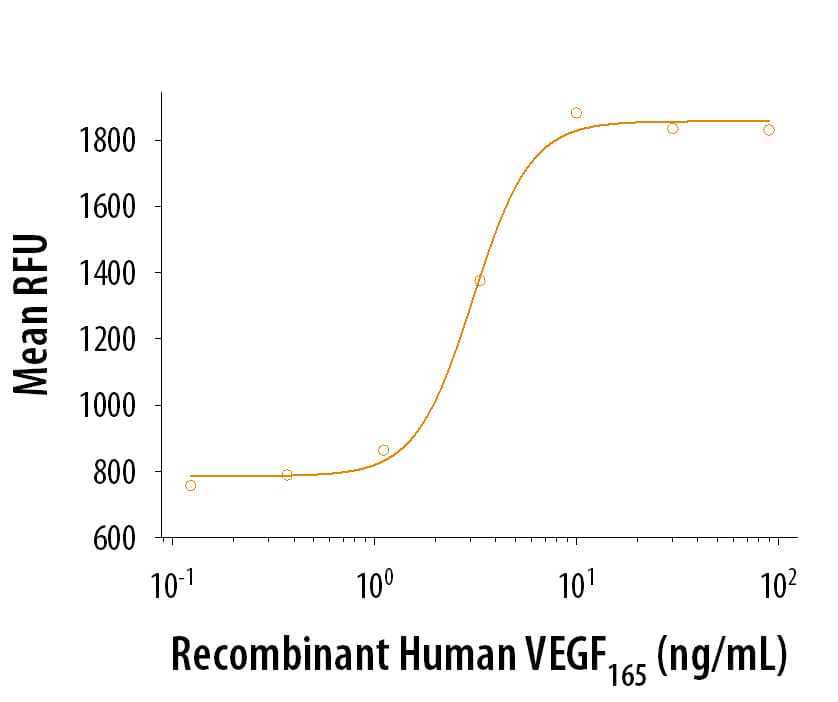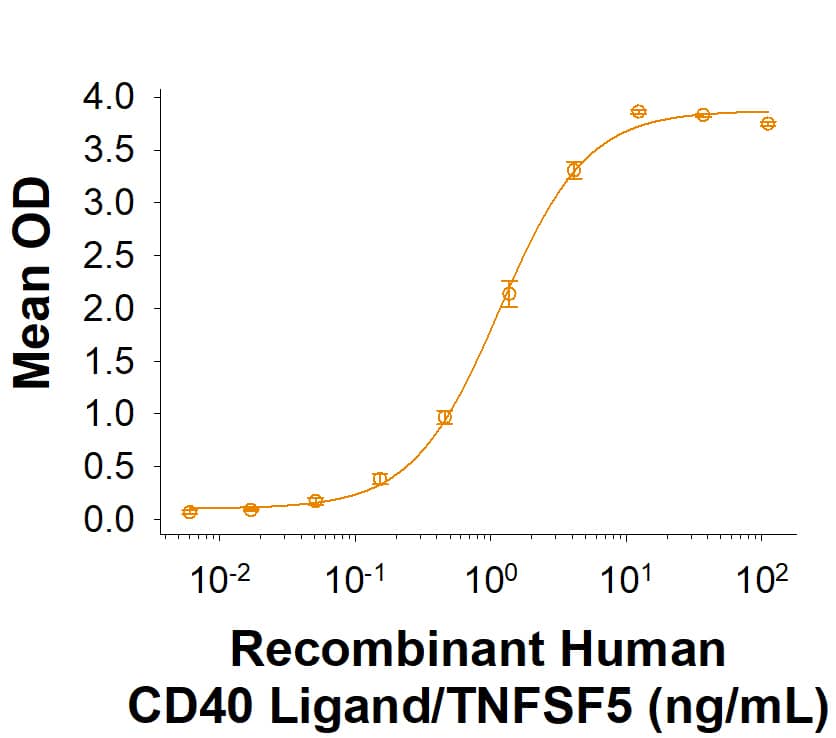Recombinant Human sCD4 Protein Summary
Product Specifications
Optimal dilutions should be determined by each laboratory for each application.
Lys26-Trp390
Analysis
Customers also Viewed
Product Datasheets
Carrier Free
CF stands for Carrier Free (CF). We typically add Bovine Serum Albumin (BSA) as a carrier protein to our recombinant proteins. Adding a carrier protein enhances protein stability, increases shelf-life, and allows the recombinant protein to be stored at a more dilute concentration. The carrier free version does not contain BSA.
In general, we advise purchasing the recombinant protein with BSA for use in cell or tissue culture, or as an ELISA standard. In contrast, the carrier free protein is recommended for applications, in which the presence of BSA could interfere.
514-CD
| Formulation | Lyophilized from a 0.2 μm filtered solution in PBS with BSA as a carrier protein. |
| Reconstitution | Reconstitute at 50 μg/mL in sterile PBS containing at least 0.1% human or bovine serum albumin. |
| Shipping | The product is shipped at ambient temperature. Upon receipt, store it immediately at the temperature recommended below. |
| Stability & Storage: | Use a manual defrost freezer and avoid repeated freeze-thaw cycles.
|
514-CD/CF
| Formulation | Lyophilized from a 0.2 μm filtered solution in PBS. |
| Reconstitution | Reconstitute at 100 μg/mL in sterile PBS. |
| Shipping | The product is shipped at ambient temperature. Upon receipt, store it immediately at the temperature recommended below. |
| Stability & Storage: | Use a manual defrost freezer and avoid repeated freeze-thaw cycles.
|
Background: CD4
CD4, also known as L3T4, T4, and W3/25, is an approximately 55 kDa type I transmembrane glycoprotein that is expressed predominantly on thymocytes and a subset of mature T lymphocytes. It is a standard phenotype marker for the identification of T cell populations (1). Mature human CD4 consists of a 371 amino acid (aa) extracellular region containing four immunoglobulin-like domains, a 22 aa transmembrane segment, and a 40 aa cytoplasmic domain (2). Within the ECD, human CD4 shares approximately 52% aa sequence identity with mouse and rat CD4. CD4 is expressed along with CD8 on double positive T cells during their development in the thymus. Either CD4 or CD8 expression is then lost, giving rise to single positive (SP) CD4+ or CD8+ mature T cells (3). CD4+ SP cells, also known as T helper cells, further differentiate into multiple subsets of CD4+ cells including Th1, Th2, Th17, Tfh, and Treg cells which regulate humoral and cellular immunity (4). CD4 is reexpressed on circulating CD8+ T cells upon activation and contributes to their cytotoxic effector activity (5). In human, CD4 is additionally expressed on macrophages, neutrophils, monocytes, NK cells, and neurons and glial cells in the brain (6-9). Similar CD4 distribution between species cannot be assumed as demonstrated by its presence on macrophages in human and rat but not in mouse (6). CD4 binds directly to MHC class II molecules on antigen presenting cells (10). This interaction contributes to the formation of the immunological synapse which is focused around the TCR-MHC class II-antigenic peptide interaction (1, 11). Palmitoylation of two cysteine residues in the cytoplasmic tail of CD4 promotes the localization of CD4 in lipid rafts and its ability to augment TCR signaling via activation of the tyrosine kinase Lck (12). CD4 also functions as a chemotactic receptor for IL-16 and, in human, as a co-receptor for the gp120 surface glycoprotein of HIV-1 (7, 13-15).
- Vignali, D.A.A. (2010) J. Immunol. 184:5933.
- Maddon, P.J. et al. (1985) Cell 42:93.
- Alarcon, B. and H.M. van Santen (2010) Sci. Signal. 3:pe11.
- Wan, Y.Y. and R.A. Flavell (2009) Mol. Cell Biol. 1:20.
- Kitchen, S.G. et al. (2005) Proc. Natl. Acad. Sci. 102:3794.
- Crocker, P.R. et al. (1987) J. Exp. Med. 166:613.
- Biswas, P. et al. (2003) Blood 101:4452.
- Bernstein, H.B. et al. (2006) J. Immunol. 177:3669.
- Funke, I. et al. (1987) J. Exp. Med. 165:1230.
- Doyle, C. and J.L. Strominger (1987) Nature 330:256.
- Huppa, J.B. et al. (2010) Nature 463:963.
- Fragoso, R. et al. (2003) J. Immunol. 170:913.
- Cruikshank, W.W. et al. (1994) Proc. Natl. Acad. Sci. 91:5109.
- Klatzmann, D. et al. (1984) Nature 312:767.
- Dagleish, A.G. et al. (1984) Nature 312:763.
Citations for Recombinant Human sCD4 Protein
R&D Systems personnel manually curate a database that contains references using R&D Systems products. The data collected includes not only links to publications in PubMed, but also provides information about sample types, species, and experimental conditions.
6
Citations: Showing 1 - 6
Filter your results:
Filter by:
-
Active Components from Cassia abbreviata Prevent HIV-1 Entry by Distinct Mechanisms of Action
Authors: Y Zheng, XW Yang, D Schols, M Mori, B Botta, A Chevigné, M Mulinge, A Steinmetz, JC Schmit, C Seguin-Dev
International Journal of Molecular Sciences, 2021-05-10;22(9):.
Species: Human
Sample Types: Protein
Applications: Bioassay -
Discovery and Characterization of a Novel CD4-Binding Adnectin with Potent Anti-HIV Activity
Authors: D Wensel, Y Sun, Z Li, S Zhang, C Picarillo, T McDonagh, D Fabrizio, M Cockett, M Krystal, J Davis
Antimicrob. Agents Chemother., 2017-07-25;0(0):.
Applications: Binding Assay -
The Effects of the Recombinant CCR5 T4 Lysozyme Fusion Protein on HIV-1 Infection.
Authors: Jin Q, Chen H, Wang X, Zhao L, Xu Q, Wang H, Li G, Yang X, Ma H, Wu H, Ji X
PLoS ONE, 2015-07-08;10(7):e0131894.
Species: Human
Sample Types: Whole Cells
Applications: Bioassay -
The HIV-1 Gp120/CXCR4 axis promotes CCR7 ligand-dependent CD4 T cell migration: CCR7 homo- and CCR7/CXCR4 hetero-oligomer formation as a possible mechanism for up-regulation of functional CCR7.
Authors: Hayasaka H, Kobayashi D, Yoshimura H, Nakayama E, Shioda T, Miyasaka M
PLoS ONE, 2015-02-17;10(2):e0117454.
Species: Human
Sample Types: Whole Cells
Applications: Bioassay -
Siglecs facilitate HIV-1 infection of macrophages through adhesion with viral sialic acids.
Authors: Zou Z, Chastain A, Moir S
PLoS ONE, 2011-09-08;6(9):e24559.
Species: Virus
Sample Types: Virus
Applications: Surface Plasmon Resonance -
Gene-trap mutagenesis identifies mammalian genes contributing to intoxication by Clostridium perfringens epsilon-toxin.
Authors: Ivie SE, Fennessey CM, Sheng J, Rubin DH, McClain MS
PLoS ONE, 2011-03-11;6(3):e17787.
Species: Human
Sample Types: Buffer
Applications: Binding Assay
FAQs
No product specific FAQs exist for this product, however you may
View all Proteins and Enzyme FAQsReviews for Recombinant Human sCD4 Protein
There are currently no reviews for this product. Be the first to review Recombinant Human sCD4 Protein and earn rewards!
Have you used Recombinant Human sCD4 Protein?
Submit a review and receive an Amazon gift card.
$25/€18/£15/$25CAN/¥75 Yuan/¥2500 Yen for a review with an image
$10/€7/£6/$10 CAD/¥70 Yuan/¥1110 Yen for a review without an image























